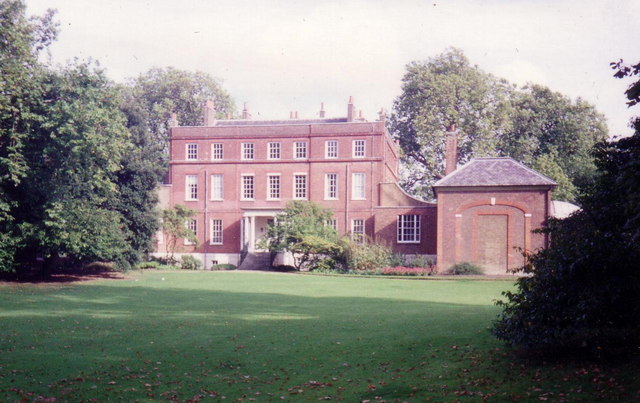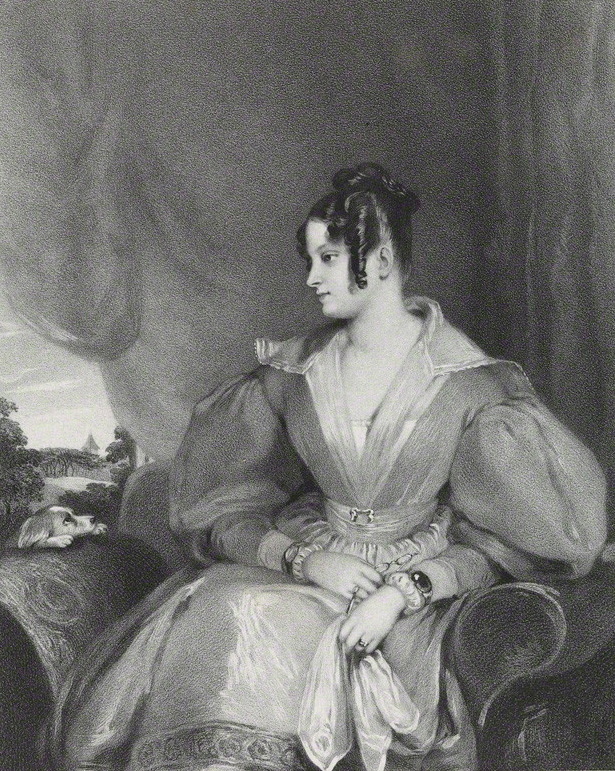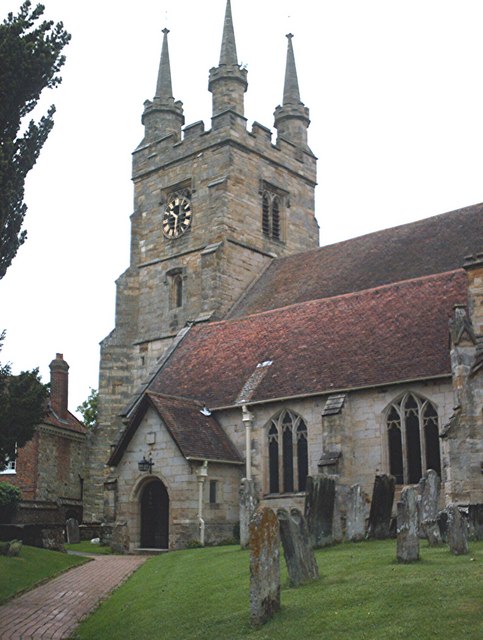by Susan Flantzer
© Unofficial Royalty 2025

St. Mildred’s Church; Credit – By Mypix at English Wikipedia, CC BY-SA 4.0, https://commons.wikimedia.org/w/index.php?curid=57460350
The History of St. Mildred’s Church
The fourth church on the site, Saint Mildred’s Church in Whippingham, Isle of Wight, England was where Queen Victoria and her family worshipped when in residence at Osborne House, the beloved home Queen Victoria and Prince Albert built in the Isle of Wight. Queen Victoria’s youngest child Princess Beatrice was married at St. Mildred’s Church and several family members are buried there including Princess Beatrice and her husband Prince Henry of Battenberg.

St. Mildred; Credit – Wikipedia
The church is named after Saint Mildrith (also known as Mildthryth, Mildryth, and Mildred), an Anglo-Saxon Abbess of the Abbey at Minster-in-Thanet, Kent, England, who was born circa 660 and died after 732.
The first church on the site was Anglo-Saxon and there are Anglo-Saxon remains of knights on horseback on the west wall of the church porch. The second church was Norman and is recorded in the 1086 Doomsday Book. In 1804, John Nash, an important architect of the Georgian era and Regency era, rebuilt the church.
Queen Victoria and Prince Albert bought Osborne House in the Isle of Wight from Lady Isabella Blachford in October 1845. However, they soon realized that the house was too small for their growing family and decided to replace the house with a new, larger residence. The new Osborne House, designed by Prince Albert and Thomas Cubitt, the London architect and builder, was built between 1845 and 1851.
Queen Victoria disliked the St. Mildred’s Church John Nash had built. She did not like the design, thought it was too small, and not private enough. Architect Albert Jenkins Humbert designed a new church with Prince Albert’s input. The chancel of the church was built in 1854 – 1855 and the remainder of the church was constructed in 1861 – 1862. The first service occurred in January 1862, a month after Prince Albert died. A side chapel, originally used by household members at Osborne House, was later made into the Battenberg Chapel after the early death of Princess Beatrice’s husband Prince Henry of Battenberg.
The Interior of St. Mildred’s Church

The Interior of St. Mildred’s Church; Credit – By Whiuppingham church interior, Isle of Wight by Ruth Sharville, CC BY-SA 2.0, https://commons.wikimedia.org/w/index.php?curid=148194849
Upon entering the church from the South Porch, the baptismal font, designed by Queen Victoria’s sixth child Princess Louise in the 1860s, is on the left. In 1863, Queen Victoria permitted Princess Louise to enroll at The National Art Training School to pursue her interests and she became a very skilled painter and sculptress. Princess Louise also designed the carpet surrounding the baptismal font and then embroidered the carpet with her sister Princess Beatrice and their ladies-in-waiting. In the late 1980s, talented women from St. Mildred’s Church restored the worn carpet.

The baptismal font and rug, both designed by Queen Victoria’s sixth child Princess Louise; Credit – By Basher Eyre, CC BY-SA 2.0, https://commons.wikimedia.org/w/index.php?curid=109283007
The Royal Pew is on the right of the chancel, the space around the altar. King Edward VII ordered pews to be placed in the chancel after his mother died. The pews replaced the plain chairs that were there during Queen Victoria’s reign, however, Queen Victoria’s chair is still there. A statue of St. Mildred is on the left of the high altar. An Anglo-Saxon princess, she was a niece of King Egbert of Kent, and the great-granddaughter of King Aethelbert of Kent.

Rose Window in St. Mildred’s Church; Credit – The Victoria Web
In the two transepts, the area crosswise to the nave, there are rose windows, copies of the rose windows in the Notre-Dame de Paris. In 1856, Queen Victoria and Prince Albert went to Paris, as guests of Napoleon III, Emperor of the French and his wife Eugénie, Empress of the French. Queen Victoria admired the rose windows and asked Prince Albert if she could have a copy in her new church at Whippingham. Prince Albert replied “My darling you may have two” and that is why St. Mildred’s Church has two rose windows.

Tomb of Princess Beatrice and her husband Prince Henry of Battenberg; Credit – By Tedster007 Own work, CC BY-SA 4.0, https://commons.wikimedia.org/w/index.php?curid=69403974
The Battenberg Chapel is opposite the Royal Pew. This was originally the Household Chapel where senior members of the royal household worshipped when in residence at Osborne House. Queen Victoria later made it into a shrine after the death of Prince Henry of Battenberg, Princess Beatrice’s husband. Members of the Battenbeg/Mountbatten family are buried in the Battenberg Chapel.
Royal Events at St. Mildred’s Church

The Marriage of Princess Beatrice by Richard Caton Woodville painted for Queen Victoria. Princess Beatrice is accompanied to the altar by her brother the Prince of Wales and Queen Victoria. Her nieces were bridesmaids, but only eight out of the total of ten are shown in the painting; Credit – Royal Collection Trust
July 23, 1885 – Wedding of Princess Beatrice of the United Kingdom and Prince Henry of Battenberg
In 1884, Prince Henry’s brother Prince Louis of Battenberg married Princess Victoria of Hesse and by Rhine, the eldest child of Queen Victoria’s deceased third child Alice, Grand Duchess of Hesse and by Rhine. Of course, Henry attended the wedding in Darmstadt, Grand Duchy of Hesse and by Rhine and so did the bride’s aunt, Princess Beatrice. Queen Victoria expected that Beatrice would never marry and would remain her personal assistant and secretary. However, during the wedding celebrations, Henry and Beatrice fell in love. When Beatrice told her mother of her desire to marry Henry, Queen Victoria did not speak to Beatrice for seven months. Eventually, the Queen realized that Beatrice would not back down and with some persuasion from the Prince of Wales, Princess Alice’s widower Ludwig IV, Grand Duke of Hesse and by Rhine, and Prince Henry’s brother Prince Louis of Battenberg, Queen Victoria decided to allow the marriage with several conditions: Henry must renounce his military career, his nationality, and his home and agree to live with Beatrice and the Queen.
A copy of Princess Beatrice’s wedding dress is on display in the South Transept along with details of the wedding breakfast and photographs.
February 5, 1896 – Funeral of Prince Henry of Battenberg
Beatrice and Henry kept their promise and lived with Queen Victoria and Beatrice remained her full-time confidante and secretary. Henry was often bored by the lack of activity and to give him more to do, Queen Victoria appointed him Governor of Carisbrooke Castle and Captain-General and Governor of the Isle of Wight in 1889, Lieutenant-Colonel in the Army in 1887, Colonel in 1893, and a member of the Privy Council in 1894.
In November 1895, Henry persuaded Queen Victoria to allow him to go to West Africa to fight in the Anglo-Ashanti Wars. Henry arrived in Africa on Christmas Day 1895. By January 10, 1896, Henry was sick with malaria and it was decided to send him back to England. Henry died aboard the ship HMS Blonde off the coast of Sierra Leone on January 20, 1896, at the age of 37.
Burials in Battenberg Chapel
- Prince Henry of Battenberg (died 1896) and Princess Beatrice of the United Kingdom (died 1944), buried in a double sarcophagus of white marble
- Alexander Mountbatten, 1st Marquess of Carisbrooke, born Prince Alexander of Battenberg (died 1960), son of Prince Henry and Princess Beatrice, ashes are in a brass casket set in a niche above his parents’ double sarcophagus.
- Irene Mountbatten, Marchioness of Carisbrooke, born Lady Irene Denison (died 1956), wife of Alexander Mountbatten, 1st Marquess of Carisbrooke, ashes are in a brass casket set in a niche
- Lady Iris Kemp, born Lady Iris Mountbatten, daughter of Alexander Mountbatten, 1st Marquess of Carisbrooke (died 1982), ashes are in a cylindrical casket set in a niche
- David Mountbatten 3rd Marquess of Milford Haven (died 1970), son of George Mountbatten, 2nd Marquess of Milford Haven and grandson of Louis Mountbatten, 1st Marquess of Milford Haven and Princess Victoria of Hesse and by Rhine, ashes are in a stone container set in a niche
Burials in the Churchyard of Battenberg Chapel
- Louis Mountbatten, 1st Marquess of Milford Haven, born Prince Louis of Battenberg (died 1921), husband of Princess Victoria of Hesse and by Rhine
- Princess Victoria of Hesse and by Rhine, Marchioness of Milford Haven (died 1950), granddaughter of Queen Victoria, daughter of Princess Alice
- Sir Henry Ponsonby (died 1895), Private Secretary and Equerry to Queen Victoria and Keeper of Her Majesty’s Privy Purse. Sir Henry’s funeral was held at St. Mildred’s Church on November 30, 1895
- Uffa Fox (died 1972), boat designer and sailing enthusiast, friend and boat racing partner of Prince Philip, Duke of Edinburgh
Memorials in Battenberg Chapel Commemorating members of Queen Victoria’s Family and Household
Chancel

Reredos, a gift from King Edward VII in memory of his mother Queen Victoria; Credit – By John Salmon, CC BY-SA 2.0, https://commons.wikimedia.org/w/index.php?curid=13870606
- Queen Victoria (died 1901) Reredos (a large altarpiece, a screen, or decoration placed behind the altar) presented by her son and heir King Edward VII.
North Transept

Memorial to Sir Henry Ponsonby; Credit – by Basher Eyre, CC BY-SA 2.0, https://commons.wikimedia.org/w/index.php?curid=109285627
- Sir Henry Ponsonby (died 1895), Private Secretary and Equerry to Queen Victoria and Keeper of Her Majesty’s Privy Purse. The bronze memorial was created by Countess Feodora Gleichen, Queen Victoria’s great-niece. Her grandmother was Queen Victoria’s half-sister Princess Feodora of Leiningen, Princess of Hohenlohe-Langenburg.

Memorial to Lord Henry Seymour-Conway; Credit – By Basher Eyre, CC BY-SA 2.0, https://commons.wikimedia.org/w/index.php?curid=109285729
- Lord Henry Seymour-Conway (died 1830) lived at his estate at Norris Castle in the Isle of Wight, where he experimented with the use of seaweed as a fertilizer.
- William Arnold (died 1801) Collector of His Majesty’s Customs
- Reverand Matthew Arnold, a Fellow of Corpus Christi College, Oxford, and Military Chaplain, drowned at the age of 35
South Transept
- Reverand George Prothero (died 1894), Chaplain to Queen Victoria, Canon of Westminster, Deputy Clerk of the Closet, and Rector of Whippingham
- Prince Henry of Battenberg (died 1896) Brass Lectern
West Wall

Memorial to Prince Albert, The Prince Consort; Credit – By Tedster007 – Own work, CC BY-SA 4.0, https://commons.wikimedia.org/w/index.php?curid=69403972
- Prince Albert, The Prince Consort (died 1861) Sir William Jenner, one of Prince Albert’s doctors, diagnosed his final illness as typhoid fever. Albert’s modern biographers have argued that the diagnosis is incorrect. Albert had been complaining of stomach pains for two years and this may indicate that he died of some chronic disease, perhaps complications from Crohn’s disease, kidney failure, or cancer.
South Wall
- Prince Sigismund of Prussia (died 1866), died from meningitis at 21 months, grandson of Queen Victoria, son of Victoria, Princess Royal

Memorial to Princess Alice; Photograph by Jacqueline Banerjee; The Victorian Web
- Princess Alice, Grand Duchess of Hesse and by Rhine (died 1878), died from diphtheria, Queen Victoria’s third child
- Prince Waldemar of Prussia (died 1879), died from diphtheria at age 11, grandson of Queen Victoria, son of Victoria, Princess Royal
- Prince Leopold, Duke of Albany (died 1884), died after a fall from a cerebral hemorrhage, the injuries exacerbated by his hemophilia), Queen Victoria’s eighth child
This article is the intellectual property of Unofficial Royalty and is NOT TO BE COPIED, EDITED, OR POSTED IN ANY FORM ON ANOTHER WEBSITE under any circumstances. It is permissible to use a link that directs to Unofficial Royalty.
Works Cited
- Hudson, T. (2022). Wootton Bridge Historical – Whippingham – St Mildred Church Tour. Woottonbridgeiow.org.uk. https://woottonbridgeiow.org.uk/stmildredchurch.php
- Queen Victoria’s Church (St. Mildred’s) – EAST COWES. (2015). Visit Isle of Wight. https://www.visitisleofwight.co.uk/things-to-do/queen-victorias-church-st-mildreds-p1069381
- St Mildred’s Church, Whippingham (2024). Wikipedia. https://en.wikipedia.org/wiki/St_Mildred%27s_Church,_Whippingham
- St. Mildred’s Church, Whippingham, Isle of Wight – Contents. (2025). Whippinghamchurch.org.uk. https://whippinghamchurch.org.uk/contents.htm
- St Mildred, Whippingham, rebuilt by A. J. Humbert (1821-1877), in collaboration with Prince Albert: Interior. (2017). Victorianweb.org. https://victorianweb.org/art/architecture/humbert/4.html
- Wikipedia Contributors. (2024). Mildrith. Wikipedia; Wikimedia Foundation.





























